Ambitious Billion-Euro Human Brain Project Kicks Off in Switzerland
The Human Brain Project, which just kicked off with an initial round of meetings in Lausanne, Switzerland, has promised to build a functional computer model of the brain to expand scientific understanding of the all-important organ. The project will also bring together the scientific literature on mouse and human brains to focus future inquiry. It will be no small task.

Share
It’s mind-blowing how little we know about the human brain. The old saw is that if our brain were simple enough to understand, we wouldn’t be smart enough to understand it.
But that's really just a cute way of saying that research on the brain is limited by the same complexity and centrality that make the organ so interesting to us. Animal models can’t shed light on the intricacies of our elaborate command centers. Even when performing brain surgery, doctors can’t see how the seemingly humble lump of grey goo works.
As computers have grown increasingly powerful and genetics more sophisticated, they have opened up new avenues for exploring how the brain’s 85 billion interconnected neurons work. The Human Brain Project, which just kicked off with an initial round of meetings in Lausanne, Switzerland, has promised to bring together the scientific literature on mouse and human brains and build a functional computer model of the human brain to expand scientific understanding of the all-important organ.
It will be no small task.
Co-headed by neuroscientist Henry Markram, a South African native who also leads the Blue Brain Project, and Karlheinz Meier, a physicist with expertise in computer modeling, the 10-year project is mainly European but has recruited some specialized teams from Israel, China, Canada and the United States.
"What we are proposing is to establish a radically new foundation to explore and understand the brain and its diseases, and to use that knowledge to build new computing technologies," Markram said in a video about the project.
Be Part of the Future
Sign up to receive top stories about groundbreaking technologies and visionary thinkers from SingularityHub.


The brain is so complex, however, that even today’s computers are not powerful enough to do that work. The work will require an exascale supercomputer, which won’t become available until roughly 2020.
“The brain has huge numbers of interacting parts: even if we had all the data we would need, simulating the relevant interactions would still be very difficult, especially at the molecular level. However, if we start work on the software now, and steer manufacturers to design machines that meet our requirements, supercomputers will soon give us enough computing power to at least begin molecular-level simulations,” the organizers explain.
The project's modeling ambitions have stirred some controversy, David Kleinfeld, a U.C. San Diego physicist who is contributing research on the vascular structure of mouse brains, told Singularity Hub.
"The good news is that, at least in the U.S., people always approach neuroscience from an illness perspective, and they’re approaching it from an engineering perspective: This is nature's way of organizing matter so that it absorbs knowledge, it's pretty incredible really," he said.
"The downside is that it’s a pretty immature field, despite the number of people involved, and it’s not clear what a central organization is going to do, if centralizing things is good or bad at the end for creativity," Kleinfeld said.
Because the field is so new, Kleinfeld said, there has been no systematic audit of previous research. That work, which comes first in the project's to-do list, may be the least glamorous but is arguably the most necessary. The results will subsequently be used to seed the computer models.
Images courtesy Human Brain Project
Cameron received degrees in Comparative Literature from Princeton and Cornell universities. He has worked at Mother Jones, SFGate and IDG News Service and been published in California Lawyer and SF Weekly. He lives, predictably, in SF.
Related Articles

This Light-Powered AI Chip Is 100x Faster Than a Top Nvidia GPU

Hugging Face Says AI Models With Reasoning Use 30x More Energy on Average

Study: AI Chatbots Choose Friends Just Like Humans Do
What we’re reading


